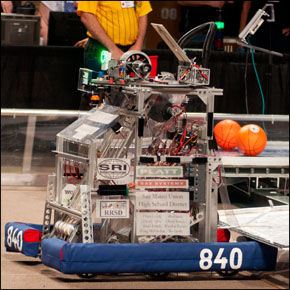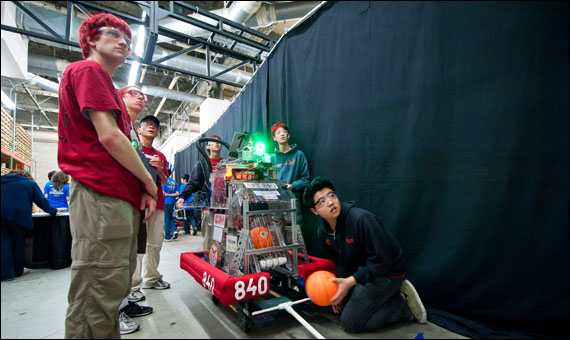

The Aragon Robotics Team (ART) concluded its competition at the FIRST international Championships in St. Louis, Missouri from April 25 to 28. ART placed eleventh out of 100 teams in the Newton Division, one of four divisions, but did not advance.
The FIRST Championships were divided into four divisions of 100 teams each where robots would compete in qualifying and elimination rounds. The qualifying rounds were a series of nine matches for each team, after which the teams would be ranked. The top eight ranked teams would then pick allies to form alliances of three. These alliances would then compete in semifinals. The winning alliances in each division would then compete in the Einstein Round for the World Championship.
Though the Aragon robotics team fared better than many on the team expected it would, the eleventh ranked team did not qualify for the semifinals. This is despite the fact that each of the top eight teams each chose two other teams to form an alliance. Senior Team Captain Anna Olson says, “Teams don’t know the other teams as well, so they have to rely on statistics and scouting data. Our data didn’t make us stand out. Championship divisions are much larger, so the rankings don’t tell you as much about a division.”
Sophomore Kenzo Makitani adds, “Basically, when you go into the semi-finals and finals, they want teams that can pick up balls and shoot them. We could only pick them up, not really shoot them.”
Makitani explains, “I think the problem was the whole mechanics — the whole picking up and having our conveyor send it to our shooter. After looking back, there were a lot of teams that integrated the two systems together. They could shoot where they wanted to shoot.”
Sophomore programmer Sean Gao and several others attribute such difficulties to the slow progress during build season. He says, “We were behind schedule and we built our bot just to be able to do the functions. We didn’t perfect any specific functions. Take our ball collection system; it’s really slow because we didn’t know how other teams would compare. We could have made it faster.
Still, the team had an opportunity to scrimmage at the NASA Ames facilities. Junior engineering lead Alvin Ho says, “We still had good testing time, because we had shooting practice for about ten hours straight in a warehouse with a hoop.”
The team chose to maneuver the shooter manually due to camera issues. Gao says, “Automated is better, it’s just that our camera had calibration issues a lot. The only thing that the robot actually can do by itself is track and shoot, and even that is inaccurate.”
Sophomore Kevin Bai says, “The shooter worked really well at the beginning of our regional, and then somebody tried to fix parts of it, and then it didn’t work well after that. Even one time it turned around 90 degrees and shot at the judges.”
However, many teams performed well at championships. Ho says, “There were definitely teams that made all the balls in without really trying. I guess it’s because they perfected their shooting over build season. They had auto-aim, shoot from anywhere on the key… There were bots that were making seven out of eight shots.”
After observing the difficulties with the shooting system, freshman programmer Guy Geva notes the difficulties in modifying the robot. Geva says, “There’s really no way to know what you’ve done until you test it. At championships, there were a hundred teams there in your division all trying to get to the practice field, and if you can’t get to practice, then the only time you could test it was at the actual competition and then it’s too late.
In addition to ART’s slight difficulties, the competition as a whole suffered during gameplay on the field. During several of the rounds, and particularly in the Einstein finals, the field wireless system sometimes failed to link up to the robots.
Ho elaborates, “We would sometimes have dead robots on the field, either on our team or on an opposing team. We would have to play with that. In the finals, almost every match, they had one dead bot.”
Though FIRST replayed the first two finals matches, both Ho and Olson feel that it significantly affected the results of the Einstein finals.
Robotics has since wrapped up the season with the announcement of next year’s team leaders and a team potluck. After reaching championships this year, Olson says, “I think we’re definitely pretty excited to have a strong next season. I think just the accomplishments and seeing how far we have come, and the crazy success story this year has been will definitely help out the team a lot in terms of both outreach and attracting sponsors because now we have something to show for all our work.”



